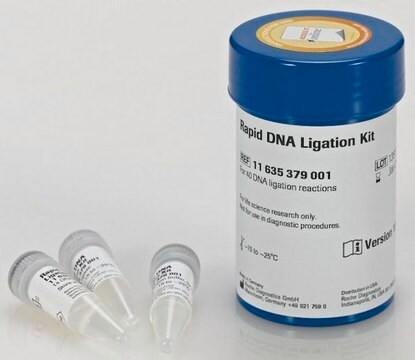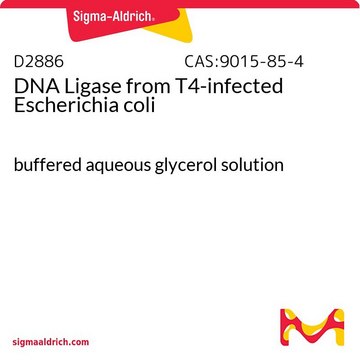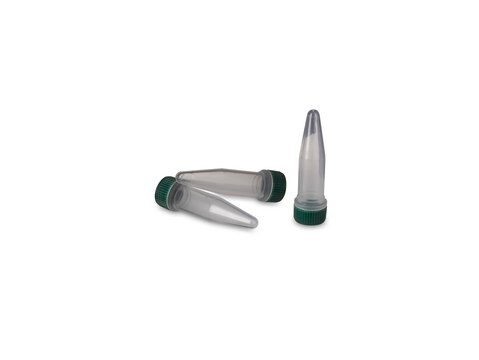LIG2
QuickLink™ DNA Ligation Kit
joins blunt-end and sticky-end DNA fragments
Sinônimo(s):
DNA Ligation Kit, Ligation Kit
Faça loginpara ver os preços organizacionais e de contrato
About This Item
Produtos recomendados
grau
Molecular Biology
for molecular biology
Nível de qualidade
Formulário
liquid
uso
kit sufficient for 50 ligation reactions
técnica(s)
molecular cloning: suitable
Condições de expedição
dry ice
temperatura de armazenamento
−70°C
Descrição geral
Sigma′s DNA Ligation Kit contains all of the reagents necessary to perform DNA ligation reactions at room temperature using blunt or sticky ends. This kit replaces previous workflows requiring cooking steps and long incubations. Pre-made buffers allow for fast & easy setup.
Aplicação
QuickLink™ DNA Ligation Kit has been used for the ligation of pGL2-basic luciferase-reporter plasmid with vascular endothelial growth factor (VEGF) promoter sequence and for the ligation of NLR family caspase activating and recruitment domain (CARD)-containing protein 4 (Nlrc4) promoter with the luciferase plasmid vector pGL4.10-luc2
The QuickLink™ DNA Ligation Kit is suitable for:
- Joining blunt or cohesive-end fragments of DNA into a cloning vector
- Recircularization of linear DNA
- Formation of concatamers
- dsDNA nick repair
Características e benefícios
- Fast 5 minutes ligation
- High ligation efficiency
- Room temperature reactions – no cooling required
- Perform bacterial transformation with the reaction mixture
Componentes
Sufficient for 50 reactions:
- 500uL 2X Ligation Buffer A (L9537)
- 100uL 5X Ligation Buffer B (L9662)
- 250 units T4 DNA Ligase (D2886) in 50% glycerol with 10 mM Tris-HCl (pH 7.5) 50 mM KCl, and 1 mM DTT
Princípio
One of the most important steps in the cloning process is the ligation of linear DNA into a cloning vector. DNA ligations are performed by incubating DNA fragments with appropriately linearized cloning vectors in the presence of buffer, ATP, and DNA ligase. Many parameters affect ligations such as the relative ratio of insert to vector, the quality and type of the DNA ends, the temperature of ligation and the concentration of DNA.
Informações legais
QuickLink is a trademark of Sigma-Aldrich Co. LLC
produto relacionado
Nº do produto
Descrição
Preços
Código de classe de armazenamento
10 - Combustible liquids
Ponto de fulgor (°F)
Not applicable
Ponto de fulgor (°C)
Not applicable
Escolha uma das versões mais recentes:
Já possui este produto?
Encontre a documentação dos produtos que você adquiriu recentemente na biblioteca de documentos.
I R Lehman
Science (New York, N.Y.), 186(4166), 790-797 (1974-11-29)
DNA ligase of E. coli is a polypeptide of molecular weight 75,000. The comparable T4-induced enzyme is somewhat smaller (63,000 to 68,000). Both enzymes catalyze the synthesis of phosphodiester bonds between adjacent 5'-phosphoryl and 3'-hydroxyl groups in nicked duplex DNA
Sambrook, J., et al.
Molecular Cloning: A Laboratory Manual, 5-5 (1989)
ErbB2 overexpression in mammary cells upregulates VEGF through the core promoter
Loureiro RMB, et al.
Biochemical and Biophysical Research Communications, 326(2), 455-465 (2005)
K Hayashi et al.
Nucleic acids research, 14(19), 7617-7631 (1986-10-10)
Polyethylene glycol (PEG) stimulates ligation with T4 DNA ligase. In 10% (w/v) PEG 6,000 solutions, only intermolecular ligation is enhanced by monovalent cations, while both inter- and intramolecular ligation occur without their presence. Similar stimulation was also caused by divalent
R Rossi et al.
Nucleic acids research, 25(11), 2106-2113 (1997-06-01)
ATP-dependent DNA ligases are essential enzymes in both DNA replication and DNA repair processes. Here we report a functional characterization of the T4 DNA ligase. One N-terminal and two C-terminal deletion mutants were expressed in Escherichia coli as histidine- tagged
Protocolos
T4 DNA ligase is used for the joining of DNA molecules with compatible cohesive (sticky) termini, joining of blunt ended double stranded DNA molecules
Nossa equipe de cientistas tem experiência em todas as áreas de pesquisa, incluindo Life Sciences, ciência de materiais, síntese química, cromatografia, química analítica e muitas outras.
Entre em contato com a assistência técnica








